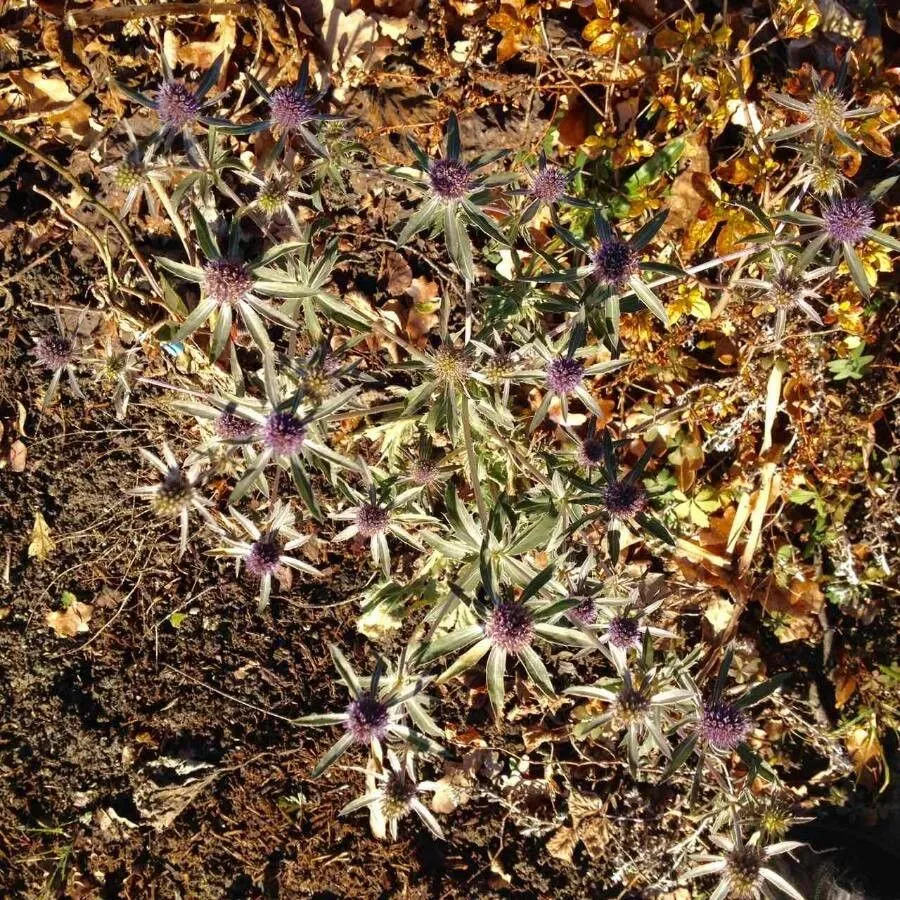
Author: L.
Bibliography: Sp. Pl.: 233 (1753)
Year: 1753
Status: accepted
Rank: species
Genus: Eryngium
Vegetable: False
Observations: Europe to Caucasus, NW. Africa
Eryngo, scientifically known as Eryngium campestre, is a distinctive and robust plant belonging to the Apiaceae family. Originating from Europe, extending across the Caucasus, and reaching into Northwestern Africa, Eryngo has firmly established its presence across these regions. Described and classified by Linnaeus in his seminal work Species Plantarum in 1753, it has been a subject of botanical interest for centuries.
Eryngo is well-recognized for its striking appearance and unique adaptations. The plant typically thrives in dry, sandy, or rocky soils, often favoring open and sunny locations. Its deep roots are indicative of its resilience, allowing it to endure drought conditions that might challenge less hardy species.
The physical characteristics of Eryngo are notable. It possesses stiff, spiny leaves that can be either a vibrant green or subtly bluish-green, adding to its visual appeal. The stems are erect and can grow distinctly, topped with dense clusters of tiny, thistle-like flowers. These flowers, which are usually blue or purple, bloom in the summer months and are a vital source of nectar for bees and other pollinators.
In traditional herbal medicine, Eryngo has been utilized for a variety of purposes. Although not as commonly used today, its historical applications included treatments for ailments such as infections and digestive issues. The plant’s toughness and longevity symbolize endurance and strength, often inspiring its usage in cultural and medicinal contexts.
Eryngo’s ecological role is also significant. As a native plant, it plays a crucial part in its habitat, supporting a range of insects and wildlife. It often contributes to the stability of the soil, helping to prevent erosion in its natural locales.
In modern horticulture, Eryngo is appreciated for its unusual beauty and low maintenance requirements. Gardeners value it for its ability to thrive in challenging conditions where other plants might struggle. Its architectural form and striking flower heads make it a popular choice for adding texture and interest to garden designs.
Overall, Eryngo stands out as a plant of considerable interest due to its ecological importance, historical uses, and fascinating botanical characteristics. Eryngium campestre continues to capture the attention of botanists, horticulturists, and plant enthusiasts alike.
Dan: bjerg-mandstro
Deu: feld-mannstreu
Eng: field eryngo, eryngo, sea-holly, white-devil, watling street thistle, snakeroot coyote-thistle
Fra: chardon roulant, panicaut des champs, panicaut champêtre
Swe: fältmartorn
Nld: kruisdistel
Cym: boglynnon, celyn y maes, celynnen y maes, ysgallen ganpen
En: Eryngo, Field eryngo, White-devil, Sea-holly, Common eryngo, Watling Street Thistle, Snakeroot coyote-thistle, Italian Eryngo
Sq: Gjembardhi
Ar: شقاقول (شَقاقول), فقاع (فُقّاع)، شقاليل (شَقاقيل), قرصعنة حقلية
Hy: Երնջակ դաշնային
Az: Çöl zımbırtikanı
Eu: Armika
Bg: Ветрогон
Ca: Card girgoler, Card panical, Gard girgoler, Panical comú
Kw: Morgelyn byghan
Hr: Kotrljan
Cs: Máčka ladní
Da: Bjerg-Mandstro
Nl: Echte kruisdistel, Kruisdistel, Wilde Kruisdistel
Eo: Kampa eringio
Fi: Kenttäpiikkiputki
Fr: Chardon roulant, Panicaut des champs, Panicaut champêtre, Chardon-Roland, Chardon-roulant, Chardon Roland
Gl: Cardo corredor
De: Feld-Mannstreu, Feld Mannstreu, Krausdistel
Hu: Mezei iringó
It: Bocca di ciuco, Calcatreppola campestre
Mk: Валавец
Fa: قرصعنه
Pl: Mikołajek polny
Pt: Cardo-corredor, Cardo-de-palma
Ru: Синеголовник полевой
Sr: Ветроваљ
Sk: Kotúč poľný
Es: Cardo corredor, Cardo santo, Cardo ventero
Sv: Fältmartorn
Uk: Миколайчики польові
Cy: Celynnen y maes, Boglynnon, Celyn y Maes, Ysgallen Ganpen
© copyright of the Board of Trustees of the Royal Botanic Gardens, Kew.
© copyright of the Board of Trustees of the Royal Botanic Gardens, Kew.
Taken Jan 21, 2019 by Dieter Wagner (cc-by-sa)
Taken Dec 28, 2018 by Dieter Wagner (cc-by-sa)
Taken Dec 28, 2018 by Dieter Wagner (cc-by-sa)
Taken Jan 21, 2019 by Dieter Wagner (cc-by-sa)
Taken Dec 28, 2018 by Dieter Wagner (cc-by-sa)
Taken Sep 24, 2020 by cath.marais (cc-by-sa)
Taken Aug 18, 2022 by Lucia Martínez (cc-by-sa)
Taken Jun 14, 2022 by Acosta García Isabel (cc-by-sa)
Taken Dec 28, 2018 by Dieter Wagner (cc-by-sa)
Taken Jan 21, 2019 by Dieter Wagner (cc-by-sa)
Taken Feb 23, 2020 by Ferndz Estebitan (cc-by-sa)
Taken Jun 14, 2022 by Acosta García Isabel (cc-by-sa)
Taken Aug 3, 2021 by velasco julen (cc-by-sa)
Taken Jun 12, 2017 by Creu Lopez (cc-by-sa)
Taken Jun 23, 2018 by Creu Lopez (cc-by-sa)
Taken Feb 16, 2019 by Juan I Deán (cc-by-sa)
Taken Oct 12, 2019 by Ismael Pizarro Muñoz (cc-by-sa)
Taken Aug 29, 2020 by Irmgard Groß (cc-by-sa)
Taken Sep 16, 2021 by Hana Kuchaříková (cc-by-sa)
Taken Oct 15, 2022 by Sandor Somogyi (cc-by-sa)
Taken Jul 18, 2019 by Viviane Rezzoug (cc-by-sa)
Taken Jun 30, 2013 by Tela Botanica − Jean-Luc Gorremans (cc-by-sa)
Taken Aug 7, 2020 by pepitruix (cc-by-sa)
Taken Aug 7, 2020 by pepitruix (cc-by-sa)
Taken Sep 24, 2020 by cath.marais (cc-by-sa)
Taken Oct 22, 2016 by Yoan MARTIN (cc-by-sa)
Taken Sep 21, 2021 by Martin David (cc-by-sa)
Taken Jun 10, 2018 by Serge Facchin (cc-by-sa)
Taken Sep 8, 2020 by Lolita1312 Lolita1312 (cc-by-sa)
Taken Jul 26, 2021 by Pierre LEON (cc-by-sa)
Growth habit: Forb/herb
Ph maximum: 8.0
Ph minimum: 7.5
Light: 9
Atmospheric humidity: 3
Bloom months: [‘jul’, ‘aug’, ‘sep’]
Soil nutriments: 5
Family: Myrtaceae Author: (F.Muell.) K.D.Hill & L.A.S.Johnson Bibliography: Telopea 6: 402 (1995) Year: 1995 Status:…
Family: Rubiaceae Author: Pierre ex A.Froehner Bibliography: Notizbl. Bot. Gart. Berlin-Dahlem 1: 237 (1897) Year:…
Family: Sapindaceae Author: Koidz. Bibliography: J. Coll. Sci. Imp. Univ. Tokyo 32(1): 38 (1911) Year:…
Family: Asteraceae Author: A.Gray Bibliography: Pacif. Railr. Rep.: 107 (1857) Year: 1857 Status: accepted Rank:…
Family: Fabaceae Author: Medik. Bibliography: Vorles. Churpfälz. Phys.-Ökon. Ges. 2: 398 (1787) Year: 1787 Status:…
Family: Aspleniaceae Author: (Cav.) Alston Bibliography: Bull. Misc. Inform. Kew 1932: 309 (1932) Year: 1932…